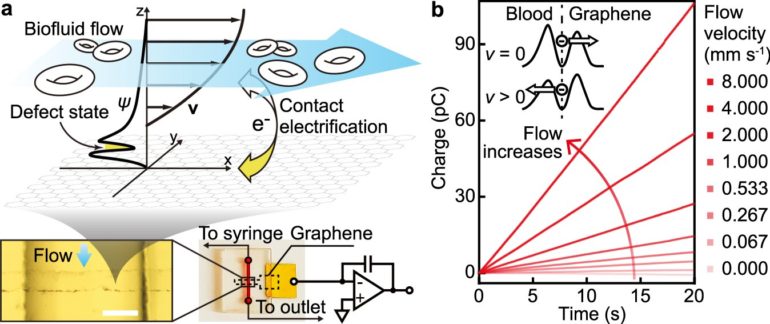A team of scientists at the University of Massachusetts Amherst have developed the thinnest and most sensitive flow sensor, which could have significant implications for medical research and applications, according to new research published recently in Nature Communications.
The research was led by Jinglei Ping, assistant professor of mechanical and industrial engineering, along with a trio of mechanical engineering Ph.D. students: Xiaoyu Zhang, who fabricated the sensor and made the measurement, Eric Chia and Xiao Fan. The findings pave the way for future research on all-electronic, in-vivo flow monitoring in investigating ultra-low-flow life phenomena that is yet to be studied in metabolism processes, retinal hemorheology and neuroscience.
Flow sensors, also known as flowmeters, are devices used to measure the speed of liquid or gas flows. The speed of biofluidic flow is a key physiological parameter but existing flow sensors are either bulky or lack precision and stability. The new flow sensor developed by the UMass Amherst team is based on graphene, a single layer of carbon atoms arranged in honeycomb lattice, to pull in charge from continuous aqueous flow. This phenomenon provides an effective flow-sensing strategy that is self-powered and delivers key performance metrics higher than other electrical approaches by hundreds of times. The graphene flow sensor can detect flow rate as low as a micrometer per second, that is, less than four millimeter per hour, and holds the potential to distinguish minimal changes in blood flow in capillary vessels. The performance of the graphene flow sensor has been stable for periods exceeding half a year.
Ping says the device his team created is the first one to be self-powered and high-performance, and it holds the potential to be implanted for long-term biofluidic flow monitoring. The most straightforward application, he added, may be in healthcare. To implant a micro flow monitor like the one his team developed in a small blood vessel is much simpler and safer than existing flowmeters, which are not suitable for low-flow measurement and need to be installed in a larger blood vessel. Ping added that scientists and doctors may find it useful for their research and clinical applications, such as monitoring the blood flow velocity in deep-brain vessels to understand the functioning of neurons that control the flow of blood.
Graphene is the key material in development of the sensor, Ping said. The unique combination of intrinsic properties of graphene, such as ultra-high sensitivity, ultra-low electrical noise, minimal contact electrification with aqueous solutions, outstanding stability in chemical and mechanical behaviors and immunity to biofouling, work together to induce the high performance of the flow sensor.
Next steps for Ping and his team include integrating the flow sensor into a self-sustained flow monitoring device and exploring the application of the device in healthcare.
Scientists develop AI platform to assess blood vessel anomalies and eye disease
More information:
Xiaoyu Zhang et al, Flow-sensory contact electrification of graphene, Nature Communications (2021). DOI: 10.1038/s41467-021-21974-y
Provided by
University of Massachusetts Amherst
Citation:
Researchers develop ultra-sensitive flow microsensors (2021, March 22)
retrieved 22 March 2021
from https://phys.org/news/2021-03-ultra-sensitive-microsensors.html
This document is subject to copyright. Apart from any fair dealing for the purpose of private study or research, no
part may be reproduced without the written permission. The content is provided for information purposes only.



